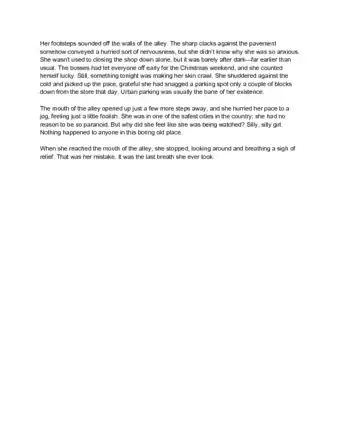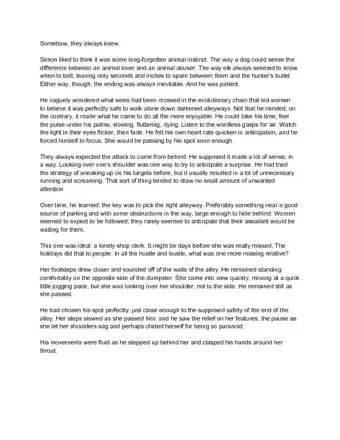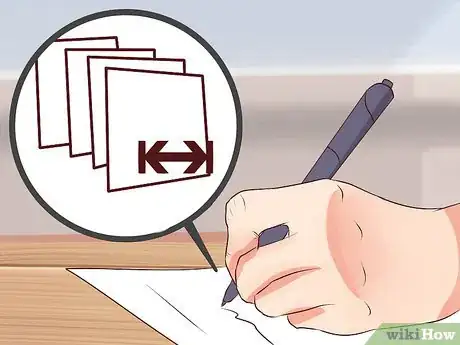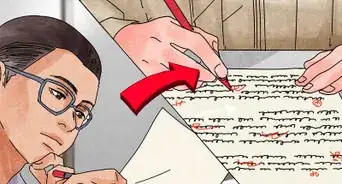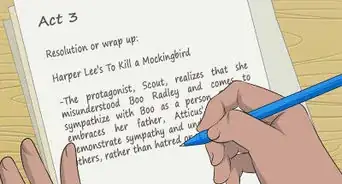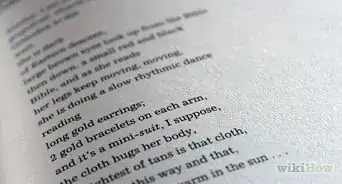This article was co-authored by Grant Faulkner, MA. Grant Faulkner is the Executive Director of National Novel Writing Month (NaNoWriMo) and the co-founder of 100 Word Story, a literary magazine. Grant has published two books on writing and has been published in The New York Times and Writer’s Digest. He co-hosts Write-minded, a weekly podcast on writing and publishing, and has a M.A. in Creative Writing from San Francisco State University.
wikiHow marks an article as reader-approved once it receives enough positive feedback. This article received 13 testimonials and 93% of readers who voted found it helpful, earning it our reader-approved status.
This article has been viewed 342,326 times.
The prologue appears at the very beginning of a novel as a section before the first chapter of the book. A good prologue will feel essential to the novel and not just a bonus chapter or a stalling tactic on the part of the writer. To write an effective prologue for your novel, you will need to first recognize the purpose of a prologue, create one (or several) drafts of the prologue and edit the prologue down so it is polished and ready for print.
Steps
Sample Prologues
Identifying the Different Uses of a Prologue
-
1Use the prologue to provide backstory. One way to use a prologue is to provide backstory on a character or several characters. This can help you, as the writer, avoid using other tricks like flashbacks or inserted backstory in the novel. This option is useful if you are struggling to cover the details of a character's past within the action of your novel.[1]
- However, many writers argue against using a prologue as a way to dump a whole bunch of backstory, or past information, on the reader. Instead, the backstory in the prologue should feel essential to the rest of the novel and contain information that could not be placed anywhere else in the novel.
- A backstory heavy prologue should reveal the origin of the quest or mission in the novel and provide the reader with information about the past that leads up to the present action in the novel. This could be the history behind an event, like a war or a conflict, that is touched on in the novel or the history of a character who is important to the novel.[2]
-
2Have the prologue hook the reader into the rest of the novel. Many writers use a prologue as a hook that intrigues the reader. This type of prologue should raise compelling questions in the reader's mind. It should give the reader a reason to turn the page and set up the reader with questions and/or images that will be addressed in the novel.[3]
- A hook prologue could present a scene that introduces character and action that become very important in the novel. It could also foreshadow what is going to happen and allow your reader to briefly meet one of your characters or several of your characters.
Advertisement -
3Use the prologue as a way to frame the rest of the novel. Some writers will use a prologue as a framing device, where a character is motivated to sit down and write the novel. The character in the prologue will then serve as the narrator for the novel.[4]
- This method can be effective if your novel is voice driven and dominated by one narrator or one to two narrators. Writers will use prologues this way if they feel they need to let the reader know why the story is being told.
EXPERT TIPGrant Faulkner is the Executive Director of National Novel Writing Month (NaNoWriMo) and the co-founder of 100 Word Story, a literary magazine. Grant has published two books on writing and has been published in The New York Times and Writer’s Digest. He co-hosts Write-minded, a weekly podcast on writing and publishing, and has a M.A. in Creative Writing from San Francisco State University.Professional Writer
 Grant Faulkner, MA
Grant Faulkner, MA
Professional WriterOur Expert Agrees: A prologue frames the story in a certain light and can create suspense about the rest of the piece. Don't think of your prologue as an extra appendage, but instead a part of the story itself that enhances the overall experience. Also, the prologue should put the story in motion.
-
4Focus on a different character perspective in the prologue. Sometimes, a prologue is used to introduce a character's point of view only once. The rest of the novel may be told from another point of view or several other point of views, and never focus again on the character in the prologue. This option is usually only done out of necessity or for a compelling reason, as you want the character's perspective to contribute to the novel as a while or reinforce themes or ideas present in the novel.[5]
- This type of prologue gives you the opportunity to use a point of view that is not used much or at all in the rest of the novel. It also prevents you from violating your POV later in the novel, as you have already addressed the one character's point of view in your prologue.
Creating a Draft of Your Prologue
-
1Choose which type of prologue fits your story. To write an effective prologue, you need to first consider which prologue type fits with your novel. Often, prologues are written after the novel has been completed or when a novel is in its finishing stages. If you are writing a prologue cold, with no other chapters written, you should still think about how the prologue is going to affect the rest of the book.[6]
- Think about how the prologue is going to enhance your novel and feel integral to the story. Will it reveal character, setting, or point of view? Will it provide backstory or frame the rest of the novel in a particular way?
- If you are writing a prologue for a completed book, you should also think about how the prologue will interact with your first chapter. The prologue should hook your reader in and be just as strong as the details and scenes in your first chapter, if not better. The prologue should not regurgitate details in the first chapter or feel redundant in any way, as this will likely lead to a boring and dry prologue.
-
2Create a scene with sensory details. Often, prologues are set within a scene, especially in action and thriller novels. This gives the prologue a fast pace and helps to engage the reader right away. You should think about which scene or scenes you would like to use in your prologue. This may be based on the character voice you decide to use for the prologue.[7]
- Use the five senses to make the scene come alive for the reader, with a focus on what the scene smells like, feels like, sounds like, and of course, how it looks. Have your character interact with these elements in the scene and use your character as a way for your reader to access the scene.
-
3Aim for a prologue with one to two scenes. Most prologues are successful if they are short and to the point. Try to use only one to two scenes in the prologue, as too many scenes can make the prologue feel too long and drawn out. Often, using one powerful scene as the prologue can be very effective and draw the reader in right away.[8]
- Avoid hopping around in time a lot in your prologue, as this can make the prologue feel confusing or jumpy to the reader. Try to stay in one time period or within one to two time periods so the prologue does not become too long.
-
4Use a specific character voice. If you decide to use your prologue as a way to access a certain character's point of view, make sure you get into the voice of your character. Think about how the character might speak to others and to themselves. Consider the age, background, and gender of the character, and how this might inform the character's voice or style of narration.[9]
- If you are using the prologue as a way to access a character that does not appear again in the novel or only appears as a minor character, use the prologue to really explore the character's perspective. This is your opportunity to show the reader more about the character and delve into what makes the character tick.
-
5Put backstory in the prologue. If the purpose of your prologue is to reveal the past moments in a character's life or to discuss the history of a character, you should make sure there is enough backstory in the draft. Include engaging details from the character's past and have the character show why these details are important or necessary to the rest of the story. Though the backstory should be about the character, it should also connect to the larger themes or ideas in the novel.[10]
Editing Your Prologue
-
1Keep the prologue short and to the point. A good prologue is usually no more than three to four pages total. Read over your draft and trim it down. Remove any details are are not necessary to the overall story or nice to have. Keeping your prologue short and to the point will make it that much more effective and ensure your reader stays engaged enough to move on to chapter 1.[11]
-
2Make sure the pace is fast and engaging. The pace of the prologue should be quick and brisk. Avoid over explaining something or giving away too much information to the reader, as you will have an entire novel to do this. You do not need to cram the prologue with information that might fit somewhere else in the novel. Keep only the essential details.[12]
- One way to check the pace of the prologue is to read it out loud to yourself or to someone else. Mark any run on sentences or awkward moments in the draft and work them over until they sound smooth and to the point.
-
3Look at how the prologue fits with the rest of your novel. Once you have edited your prologue, you should place it in front of your chapter 1 and look at how it fits. Does it feel like an engaging start? Does it contain any information that is also in chapter 1? Does it strengthen the novel overall?[13]
- Your prologue should be strong enough to stand on its own, separate from the novel. It should almost read like a short story, with a contained story line and a conflict. However, unlike a short story, the ending of your prologue should remain open. It can introduce a conflict that will be resolved or addressed later in the novel, leaving the reader wanting more.
Community Q&A
-
QuestionIs it good to end the prologue on a cliffhanger to hook readers in?
 Community AnswerYes, it intrigues readers to read the rest of the novel. Ending the prologue on a cliffhanger will make a great prologue.
Community AnswerYes, it intrigues readers to read the rest of the novel. Ending the prologue on a cliffhanger will make a great prologue. -
QuestionHow can I keep from giving too much information away in the prologue?
 Community AnswerDon't add too much detail or dialogue, and keep the length somewhat short. Most prologues are hooks, so just reel the reader in, then change to the first chapter.
Community AnswerDon't add too much detail or dialogue, and keep the length somewhat short. Most prologues are hooks, so just reel the reader in, then change to the first chapter. -
QuestionShould I type "prologue" in the manuscript?
 Community AnswerYes, because the prologue is part of the book.
Community AnswerYes, because the prologue is part of the book.
References
- ↑ http://www.foremostpress.com/authors/articles/prologue.html
- ↑ http://www.writersdigest.com/online-editor/4-approaches-for-the-first-chapter-of-your-novel
- ↑ https://www.scribendi.com/advice/how_to_write_a_prologue.en.html
- ↑ http://www.foremostpress.com/authors/articles/prologue.html
- ↑ http://www.foremostpress.com/authors/articles/prologue.html
- ↑ http://lindasclare.com/2016/01/writing-a-prologue/
- ↑ http://lindasclare.com/2016/01/writing-a-prologue/
- ↑ http://www.foremostpress.com/authors/articles/prologue.html
- ↑ http://www.foremostpress.com/authors/articles/prologue.html
About This Article
The prologue is the section of a novel that comes just before the first chapter, and a good one should have a clear purpose with well-polished writing. Start by choosing what you want your prologue to accomplish. You can use it to provide backstory before the reader starts the novel, as a teaser to hook the reader, or even as a way to frame the rest of the novel. For instance, the prologue can be about a character sitting down to write the novel, so they can then be the narrator for the rest of the book. Once you’ve identified the purpose of your prologue, write your first draft, and focus on keeping it short and to the point. Try to use only 1-2 scenes to draw the reader into the novel. When you edit your draft, check the grammar and spelling, and keep only the essential details so it’s fast-paced and engaging. For tips about how to use a specific character voice in your prologue, keep reading!
